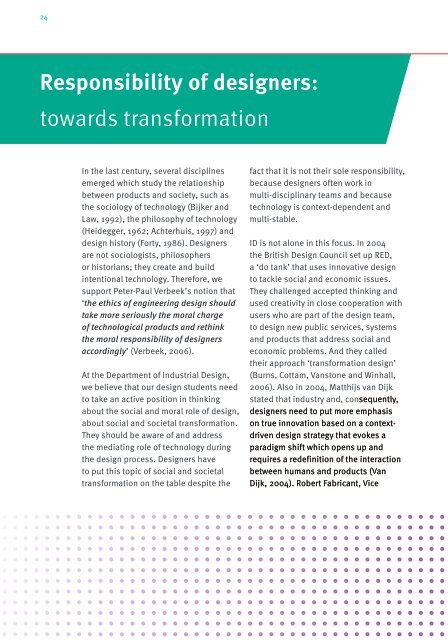Education guide 'Eindhoven designs' - Technische Universiteit ...
Education guide 'Eindhoven designs' - Technische Universiteit ...
Education guide 'Eindhoven designs' - Technische Universiteit ...
Create successful ePaper yourself
Turn your PDF publications into a flip-book with our unique Google optimized e-Paper software.
24<br />
Responsibility of designers:<br />
towards transformation<br />
In the last century, several disciplines<br />
emerged which study the relationship<br />
between products and society, such as<br />
the sociology of technology (Bijker and<br />
Law, 1992), the philosophy of technology<br />
(Heidegger, 1962; Achterhuis, 1997) and<br />
design history (Forty, 1986). Designers<br />
are not sociologists, philosophers<br />
or historians; they create and build<br />
intentional technology. Therefore, we<br />
support Peter-Paul Verbeek’s notion that<br />
‘the ethics of engineering design should<br />
take more seriously the moral charge<br />
of technological products and rethink<br />
the moral responsibility of designers<br />
accordingly’ (Verbeek, 2006).<br />
At the Department of Industrial Design,<br />
we believe that our design students need<br />
to take an active position in thinking<br />
about the social and moral role of design,<br />
about social and societal transformation.<br />
They should be aware of and address<br />
the mediating role of technology during<br />
the design process. Designers have<br />
to put this topic of social and societal<br />
transformation on the table despite the<br />
fact that it is not their sole responsibility,<br />
because designers often work in<br />
multi-disciplinary teams and because<br />
technology is context-dependent and<br />
multi-stable.<br />
ID is not alone in this focus. In 2004<br />
the British Design Council set up RED,<br />
a ‘do tank’ that uses innovative design<br />
to tackle social and economic issues.<br />
They challenged accepted thinking and<br />
used creativity in close cooperation with<br />
users who are part of the design team,<br />
to design new public services, systems<br />
and products that address social and<br />
economic problems. And they called<br />
their approach ‘transformation design’<br />
(Burns, Cottam, Vanstone and Winhall,<br />
2006). Also in 2004, Matthijs van Dijk<br />
stated that industry and, consequently,<br />
designers need to put more emphasis<br />
on true innovation based on a contextdriven<br />
design strategy that evokes a<br />
paradigm shift which opens up and<br />
requires a redefinition of the interaction<br />
between humans and products (Van<br />
Dijk, 2004). Robert Fabricant, Vice

















